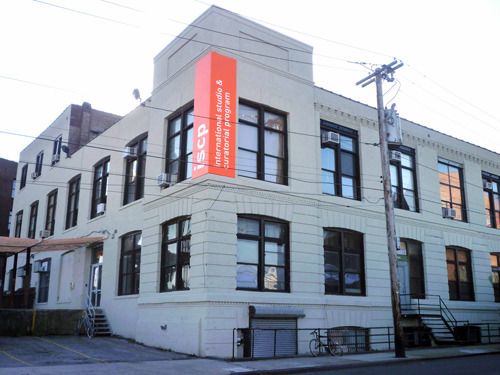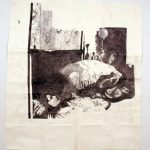Con Edison Immigrant Artist Program Newsletter, Issue No. 36
Featured Organization: The International Studio and Curatorial Program (ISCP)
The International Studio and Curatorial Program (ISCP) is a residency-based arts initiative located in Williamsburg, Brooklyn that has hosted over 1,300 mid-career national and international artists and curators.
ISCP’s programming consists of 3 components: the Residency Program, Exhibition Program, and Participatory Projects. Through this approach, residents are able to have a well-rounded residency experience. With Participatory Projects, they also have an opportunity to initiate public projects in the Local Neighborhood. In addition, ISCP has engaged in programming and dialogue with international arts institutions in order to investigate the dynamic impacts of residencies on the consciousness of societies. With a diverse group of residents and critical dialogue with similar organizations around the world, ISCP strives to engage New York audiences with exceptional artistic practices while developing the holistic residency experience. As NYFA’s Immigrant Artist Project will be engaging ISCP in a panel on International residencies this July, this interview conducted by NYFA’s IAP Program Officer Karen Demavivas and Intern Dennis Han is timely in highlighting this organization’s work.
IAP: ISCP’s Residency Program, which is comprised of 4 components – Visiting Critics, Field Trips, Salons and Open Studios, seems to be a well-rounded and integrated approach. Can you explain why and how you have developed these components for your program?
ISCP: Each aspect of the residency program facilitates dialogue, cultural exchange and immersion into New York City’s contemporary art community. The many residents who have varying aims for their time in New York necessitates that ISCP remain fluid and be able to support and facilitate many residency models at once, creating a balance between discussion, research, production, exhibitions and network-building.
IAP: Can you share your approach to selecting artists for your Residency Program? What background qualities do you look for in your candidates that would fit into the vision and values of ISCP?
ISCP: Our selection process follows three different paths. The first is when one of our partner sponsors (these are usually national, state or civic arts councils) convenes a jury to select the artist or curator. This approach allows those with specialized knowledge of a country’s art production to make the selection. In another case, ISCP chooses the resident from a shortlist that is also determined in the artist or curator’s home country. Lastly, ISCP also accepts direct applications. Each month we organize a panel and accept one or two artists or curators that apply to us directly. Foremost in the selection is the quality of work, followed by how ISCP can benefit the development of the practice and career of the person applying.

IAP: You mention that your Visiting Critic Series is the hallmark of ISCP programming. In this series, distinguished professionals from the New York and international art worlds meet privately with each ISCP artist/curator for dialogue and critical feedback. How has this interaction fostered the work and networks of the residents at ISCP?
ISCP: It is difficult to trace all that has developed from the Visiting Critic series at ISCP, there are many invisible networks that have been initiated as a result. Artists have received many New York City and international exhibition invitations, often dialogue between the residents and critics has continued for years and feedback from the critics has shaped the residents’ practice.
IAP: You have featured international artists, curators and critics and explored vital issues involving the dynamics of residencies both nationally and abroad. One such example is your Residencies Talk Series with ArteEast where you explore how residencies differ in non-western landscapes in areas such as funding and how this affects national identity and community. Can you share some other insights from these discussions?
ISCP: While there are many residency programs, there is a lack of critical discussion and publication initiatives around them. As the largest international visual arts residency program in the United States, one of our current aims is to produce knowledge in the field. ArteEast is a remarkable organization that works with some of the most relevant cultural practitioners in the Middle East and its diasporas and so collaborating with them on this talk series was a natural pairing. The Middle East has a developing contemporary art infrastructure and it seems that as many new institutions are formed, residencies have become integral to their programs. This is a different landscape than what we see in the United States, where residencies are often auxiliary programs but are not necessarily part and parcel of the institution’s activities.
IAP: Please tell us about the Participatory Projects component of ISCP. What are some projects that have resulted from Participatory Projects in New York City?
ISCP: Participatory Projects commission and produce the work of ISCP current residents and alumni in the public realm and was developed in response to the increase in resident proposals for creating new site-specific work. Residents are often inspired by New York City, including ISCP’s immediate neighborhood of East Williamsburg. This section of Brooklyn contains one of the largest industrial zones in the city and is adjacent to a residential area with a population that is both diverse and engaged with strong local traditions. These elements contribute to a sense of open space and possibility now largely absent elsewhere in the city.
We have collaborated with a network of individuals and organizations throughout the city including Build It Green! NYC, the New York City Department of Cultural Affairs, the NYC Department of Transportation Urban Art Program, Brooklyn Economic Development Corporation, and the New York City Department of Parks & Recreation, enabling artists and curators to realize ambitious new projects such as Minja Gu’s Atlantic-Pacific co. and Lotte Van den Audenaeren’s Potentialis at Moore St. Market, Kate Newby’s All parts. All the time. at Cooper Park and Olive St. Garden, Rena Leinberger’s When it opens like this, up is not over under the Queensboro Bridge, and Rose Nolan’s Wall Work and Tang-Wei Hsu’sConstellations at Brooklyn Preparatory High School.
IAP: What are some current and upcoming initiatives you are excited about at ISCP?
ISCP: ISCP does not slow down in the summer! On June 27th we open the exhibitionSecondary Witness, curated by Maayan Sheleff who is a Curator at the Center for Contemporary Art (CCA) in Tel Aviv. This will be Maayan’s first curated exhibition in New York and includes video works that touch upon the notion of testimony and explore the artist’s position as mediator. Artists in this exhibition are Lana Cmajcanin, Dor Guez, Adela Jusic (an ISCP alum from 2011), Juan Manuel Echavarria, Avi Mograbi and Michael Zupraner.





